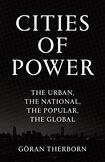
For the first time in history more than half the world lives in cities. For centuries the attraction and power of cities have been growing, seeming even to threaten the continuity of the nations that surround them. Witness the oil-funded enclaves of the Gulf States or the semi-serious calls for London to follow Scotland's lead and hold a referendum on leaving the UK. London is, according to Göran Therborn's Cities of Power, the first truly global city, marked as much by the desires of globalised capital investment as by the common values of its citizens and governments.
Cities of Power traces the convoluted paths today's capital cities have taken towards becoming "modern", their relationships to their host nations and the architectural markers that represent, monumentally or unconsciously, the dominant powers in that urban environment.
The book is split into two major parts. The first is a macroscopic overview of the development of nation states and their capitals in different parts of the world. The second is a more ideologically driven look at the particular intentions, operations and consequences of fascism, communism and globalised capitalism in particular cities.
The final two chapters bring this analysis up to the present day, with an examination of skyscrapers: their aesthetic history, their symbolism and their entanglement with the driving forces of contemporary capitalism, namely banks, multinational corporations and nation states themselves.
Bourgeois states
The primary idea developed through the first section of the book is that nation states, as distinct from “princely”, monarchical, colonial or feudal states, were essentially bourgeois creations. They represented, almost without exception, consolidations of power by the merchant and industrial classes of the day; the powers that would be (powers of investment, powers of vision, powers of return on capital) rising up against the royal and aristocratic powers that were.
Therborn makes a key point in saying that the nation state is a state always open to the future, a state that can collectively envision and make decisions about that future, rather than one defined and limited by a bloodline rooted in the past. This also means that nationalism and national identity are not part of Therborn’s analysis here beyond their intersection with a more strictly political agenda of “state power”.
That said, he is certainly alive to the social and racial divides of the cities he examines, such as the particular disdain reserved for Washington, DC, where the “poor black areas” of that majority-black city are “mostly invisible to congressmen and think-tankers as well as to casual visitors”.
In the chapters on fascism and, particularly, communism Therborn is refreshingly open-eyed. The discussion of fascism focuses on the imperialist foundation of Hitler and Mussolini’s reigns, and the impact of that aesthetic on their respective capital cities.
Although there is a qualified respect for fascist Rome’s accommodation of modernist thinking and design against an ancient backdrop, Therborn clearly shares Albert Speer’s father’s thoughts on Hitler’s architectural plans for Germany: everyone had gone completely mad.
On the other side of the ideological divide, Therborn is wise to the failures of the communist states, which were many and varied, but also cognisant of their successes.
What is most impressive, in both chapters, is Therborn’s commitment to the distinct character of the capitals he surveys: their architectural styles and urban developments are never subsumed under the blanket of “totalitarianism”, finding instead a shifting pattern of national character and historical context, bureaucratic power games and popular resistance.
It has become common practice to treat everything east of Berlin before 1990 as either monotonous or insane (and dreary either way); Therborn restores some life, colour and ambition to the people who actually lived there.
Too encyclopaedic
Although he is explicit in saying that his aim is not to be encyclopaedic, the first half of the book particularly could do with being somewhat less so. The sheer accumulation of information leaves little space for narrative detours, with many fascinating titbits left tantalisingly unexplored. It would have been interesting to hear more about Lima’s “proud modernist plebeian culture” or to see the history of Milwaukee socialism expanded outside of a footnote.
The sweep of the book is impressive, but perhaps making the space for some more of these less evidential but more characterful stories would have made it a more engaging read.
Therborn is at his best, as a writer, when he allows more of his humour and personal insight to show through, such as in his trips to Astana and Naypyidaw, or in giving “special thanks” to Jimmy Carter security adviser Zbigniew Brzezinski for fuelling “anti- modernism” in Afghanistan (and thereby creating a breeding ground for “contemporary Islamist jihadism and terrorism”).
In passages without this bite, the movement of the book can become overly abstract, slipping away from the reality of the people who populate the cities under the microscope.
Cities of Power does not truly reward being read cover to cover, but it does provide a comprehensive overview of an increasingly important subject and should become an early port of call for anyone looking to know more about how urban and national power functions around the world.
The feeling upon finishing is not one of now knowing all the answers; rather, as with any good and useful book, one is left with a more informed and more varied set of questions.










